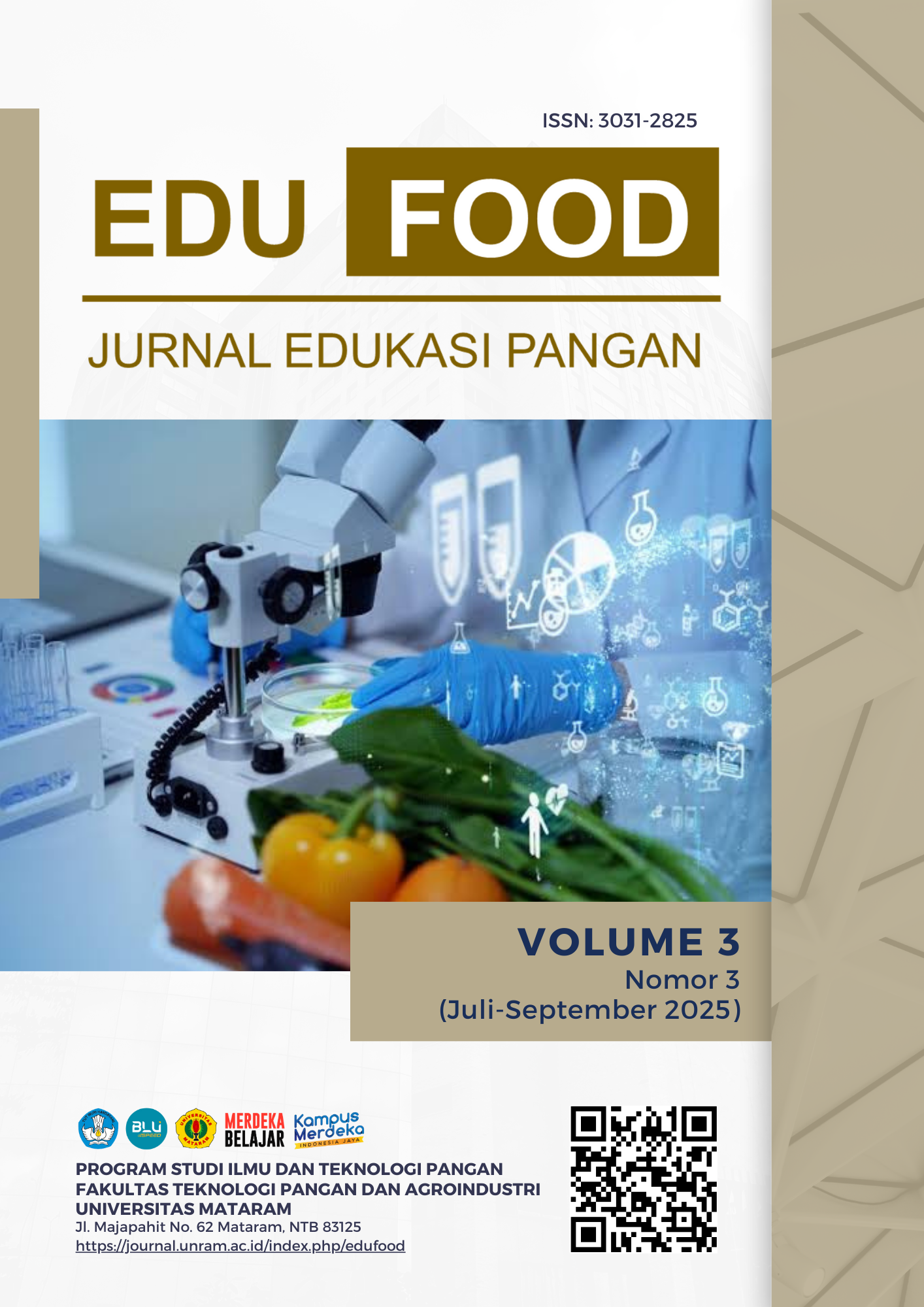THE EFFECT OF MORINGA BLANCHING TIME AND MINT CONCENTRATION ON THE PHYSICOCHEMICAL AND ORGANOLEPTIC PROPERTIES OF TEA
Keywords:
blanching, moringa leaves, mint leaves, teaAbstract
Physicochemical and organoleptic characteristics are important factors that impact the acceptance of the product by the consumer of moringa tea as a healthy beverage. This study aims to determine the effect of moringa blanching time and the concentration of mint leaf additionon the physicochemical and organoleptic properties of tea. This study was designed using a factorial Completely Randomized Design (CRD) with a 2x3 factorial pattern with 3 repetitions. The first factor the moringa leaf blanching time, namely 4 minutes and 8 minutes, while the second factor is the concentration of mint leaf addition of 0%; 5%; and 10%. The parameters tested were chemical (polyphenol content, antioxidant activity, and water content), physical parameters (turbidity and color includes L* value and oHue value), and organoleptic parameters (aroma, taste and color) hedonic and scoring. The observation data were analyzed for diversity with a 5% significance level using Co-Stat software and further testing was carried out with Honestly Significant Difference (HSD). The results showed that the interaction between moringa blanching time and mint concentration had a significantly different effect on antioxidant activity, but did not provide a significantly different interaction in the hedonic and scoring organoleptic tests of aroma, taste and color. Whereas, the individual moringa blanching time gave a significantly different effect on water content, turbidity, L* value, and oHue value. The concentration of mint addition individually gave a significantly different effect on the polyphenol content of moringa-mint tea. The best treatment that was closest to the SNI standard was with a moringa blanching time of 8 minutes and a mint concentration of 10% with a polyphenol content of 38.5 mg GAE/g; antioxidant activity of 75.97%; water content of 0.93%, turbidity of 96.67 NTU; L* value of 58.45%; oHue value of 263.65o (blue); and organoleptic with a hedonic response that was rather preferred by the panelists.
References
Abano, E, E., Amoah, R, S., Mbabazi, C. 2020. Microwave and Steam Blanching as Pre-Treatments Before Air Drying of Moringa Oleifera Leaves. Journal of Agricurtural Engineering. Vol LI:1044, 200-208
Afrianti, L. H. 2013. Teknologi Pengawetan Pangan. Alfabeta. Bandung.
Anggraini, T., Silvy, D., Ismanto, S, D., dan Azhar, F. 2014. Pengaruh Penambahan Peppermint (Mentha piperita L.) Terhadap Kualitas Teh Daun Pegangan (Centella asiatica, L. Urban ). Jurnal Litbang Industri. 4 (2) : 79-88.
Badan Standarisasi Nasional Indonesia. 2013. SNI 3836:2013 Teh Kering dalam
Kemasan. Badan Standarisasi Nasional, 1–11.
Bella, C, M., Triana, L., dan Nurud, D. 2016. Pengaruh Variasi Waktu Blanching dan Konsentrasi Asam Sitrat Terhadap Karakteristik dan Aktivitas Ekstrak Pigmen Ubi Jalar Ungu (Iponoea batatas L). Jurnal Pertanian Pangan. 1 (1) : 69-67.
Farhan, H., Rammal, A., Hijazi, A., dan Badran, B., 2012. In Vitro Antioxidant
of Ethanolic and Aqueous Extracts from Crude Malva Parviflora L.
Grown in Lebanon. Asian Journal of Pharmaceutical and Clinical
Research, 5 (3), 234-238.
Fitri, H. 2023. Pengaruh Penambahan Daun Mint (Mentha piperita L.) Terhadap Karakteristik Teh Kahwa Daun. Skripsi. Universitas Andalas : Padang.
Indriasari, Y., Basrin, F., dan Salam, M, B, H, B. 2019. Analisis Penerimaan Konsumen Moringa Biscuit (Biskuit Kelor) Diperkaya Tepung Daun Kelor (Moringa oleifera). Jurnal Agroland, Vol 26 (3) : 221-229
Irwan, Z. 2020. Kandungan Zat Gizi Daun Kelor (Moringa Oleifera) Berdasarkan Metode Pengeringan. Jurnal Kesehatan Manarang, 6 (1).
Leita, D, I., Rohadi., dan Putri, A, S. 2018. Sifat Antioksidatif Ekstrak Teh (Camellia sinensis Linn.) Jenis Teh Hijau, Teh Hitam, Teh Oolong Dan Teh Putih Dengan Pengeringan Beku (Freeze Drying). Jurnal Teknologi Pangan dan Hasil Penelitian. 13 (1)
Pramono, R., Hulu, M., Larosa, D, B., Agungputranto, A., dan Kusumo, H, K, E. 2022. Pengolahan Minuman Tradisional Berbahan Dasar Daun Kelor Di Kampung Wisata Kranggan Kota Tangerang. Jurnal Prosiding PKM-CSR. Vol 5. e-ISSN: 2655-3570
Riachi, L, G., and De Maria, C, A. 2015. Peppermint Antioxidants Revisited. Food Chemistry. 176. 72-81.
Sudarmadji, S. B., Haryono., dan Suhardi. 2007. Prosedur Analisa untuk Makanan dan Pertanian. Yogyakarta: Liberty.
Suyatma. 2009. Diagram warna hunter (Kajian pustaka). Jurnal Penelitian Ilmiah Teknologi Pertanian, Institut Pertanian Bogor, Page 8 -9
Vita, N, L., dan Gilian, T. 2019. Daya Terima Minuman Sari Buah Pisang Tongka Langit dengan Perlakuan Lama Blansing. Jurnal teknologi Pertanian. 8 (1) : 24-28
Wilanda, S., Nita, Y., dan Ketut, I, B. 2021. Kajian Mutu Dan Aktivitas Antioksidan Teh Kulit Kopi (Coffea canephora) Dengan Penambahan Daun Mint (Mentha piperita L). Jurnal Reseach Ilmu Pertanian. 1 (1) : 76-83
Zendy, V, R., dan Ida, A, S. 2021. Pengaruh Berbagai Perlakuan Blansing dan Suhu Pengeringan Terhadap Karakteristik Organoleptik Tepung Tangkai Daun Sawi (Brassica juncea). Procedia of Engineering and Life Science, vol 1 (1)


